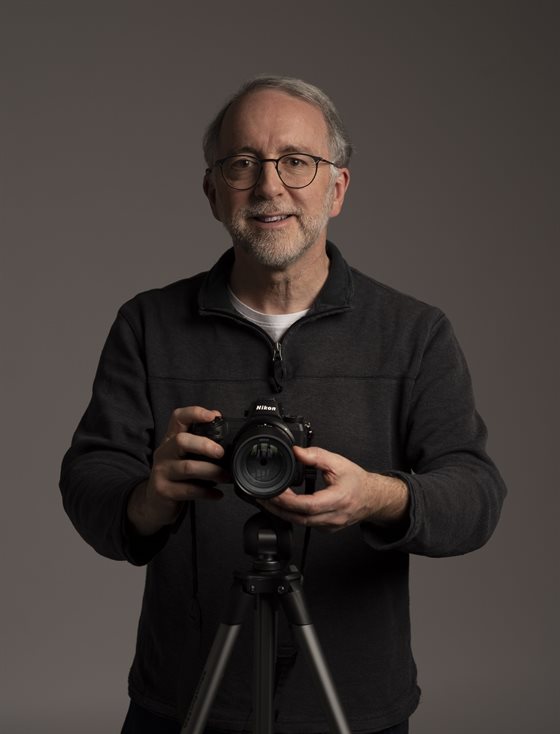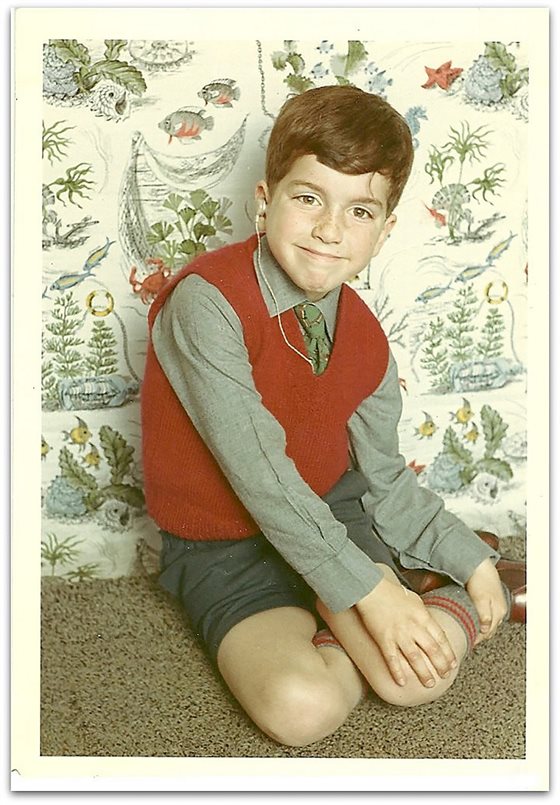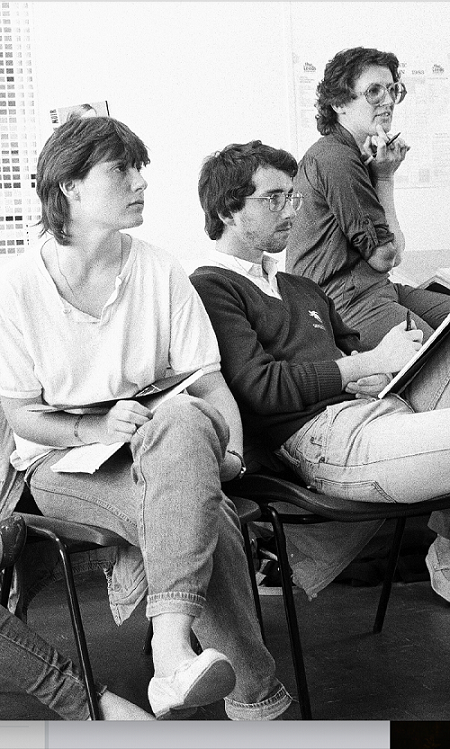Award-winning photographer Stephen Iliffe is one of the approximately 900,000 people in the UK who are severely or profoundly deaf. Growing up in the shadow of Leicester City’s Filbert Street stadium, there was no deaf figure in his life to look up to.
Stephen enrolled at De Montfort University Leicester (DMU) - formerly Leicester Polytechnic – and after discovering the deaf community in his 20s, he dedicated his life to championing people just like him.
Now, 40 years after graduating, Stephen is back at DMU to showcase his exhibition, Deaf Mosaic, a celebration of everyday people from all walks of life who share one thing in common: a positive deaf identity that goes beyond negative ideas about ‘hearing loss’.
Deaf Mosaic recently opened in the atrium of the Vijay Patel Building at DMU and runs until Friday 3 May. We caught up with Stephen, who’s excited to be showcasing his work in his hometown.
“I actually studied in the spot where the exhibition is being hosted,” he said. “It’s amazing to see how much it has transformed.”
The 27 portraits that make up Deaf Mosaic adorn the far walls of the Vijay Patel Building. Somewhat inconspicuous, the exhibition doesn’t stand out immediately, rather it blends in with the existing decor and that’s its true beauty. It reflects real life. Members of the deaf community, of which there are hundreds of thousands in the UK, are hard to pick out in a crowd because it can affect anyone from any social background. Deafness does not discriminate.

Bullied for his clunky transistor hearing aid during school, Stephen wanted to showcase how people have embraced deafness and gone on to live extraordinary and fulfilled lives.
In Deaf Mosaic, Muslim kickboxers share the wall with the likes of CEOs, travellers, athletes, religious figures and children, all from different ethnicities and backgrounds with each portrait giving a glimpse into their lives.
Celebrating deafness
The exhibition is a first for Leicester. Despite the city’s diverse culture and appetite for the arts, there has never been a photography showcase that celebrates deaf people. It’s the first time the exhibit has travelled outside of London, having previously stood in the Brick Lane Gallery, OXO Gallery and as part of the Kings Cross Outdoor Art Project.
“We’re thrilled to welcome one of our graduates back to campus,” said DMU photography course leader Mark Kasumovic. “Stephen has an important message to share with the general public. He will also inspire our students by demonstrating that photography still has a vital role to play in documenting people's lives and highlighting urgent issues.”
Among the portraits is Stephen’s wife of 35 years, Emma, whom he met at a Christmas party. The pair have two children, Ben and Sophie, and his impromptu snap captured a moment of inner peace in his wife’s life, who was on a break from teaching British Sign Language (BSL) courses.
“As she took a short break, the sun came out. Emma’s usually a bundle of constant energy and movement. Here she was, momentarily still, at peace,” the caption reads.
When asked if he has any favourite portraits, Stephen modestly replies that there are no favourites, but draws his attention to Asha Hylton, a team leader in a critical care team at Kings College London.
“Asha’s severely deaf but in a position of enormous responsibility, working with very ill children,” Stephen says. “Deafness is not a disability, it’s the environment and as long as you adapt that environment, deaf people can do anything. Asha is a great example of that.”
“She can communicate one-on-one like I can but in team meetings, she will use note-takers or interpreters and has special equipment on her stethoscope to enable her to use it. It’s a really good example of how deaf people can adapt to situations.
“I met her post-lockdown but hospitals were still being impacted by the pandemic. Asha is dependent on reading lips but masks made that virtually impossible for her and eventually forced her off the front line for several months.
“I arranged to meet up with her outside the hospital and she pulled down her mask revealing her face and I captured her expression, which, to me, said ‘I can’t wait to get rid of this thing’ because it was making communication difficult. She’s now back on the front line, thankfully.”
Navigating early challenges
Stephen came to Leicester Polytechnic to study Photography and Graphic Design in 1981 following a challenging school experience.
Unable to hear the teacher above the noise of the classroom, and relying on predominantly lipreading, he would become mentally fatigued by mid-morning and his attention would turn to what was happening outside the window.
Video
Can you read Stephen’s lips for the entire 30 seconds?
Gazing out the window and paying attention to the landscape helped sharpen his eye for what made something visually appealing, as well as his love for rock music album covers and comic books.
Inspired by the art design group Hipgnosis, whose notable designs include Pink Floyd's Dark Side of the Moon and Led Zeppelin’s Houses of the Holy, Stephen became infatuated with the power of visuals.

A young Stephen, aged five, before school
Stephen says: “Hipgnosis used photography in an incredibly creative kind of way to make it look like art and it really resonated with me. In those days, Leicester Polytechnic was one of two places that offered both photography and graphic design as a combination, teachers recommended it and I was local, so it naturally drew me in.
“It was a really good course as well. Peter Rea, who was the course leader and sadly not with us anymore, told me that you’re not just learning a trade but you’re getting an education for life.
“I muddled through, my lecturers were very understanding and took time to explain things one-on-one or would give me lecture notes. I made friends. I’m still in contact with one of the visiting lecturers there, Orde Eliason.
“It was a great choice to go through DMU.”
Like many alumni before and after him, Stephen learned his trade in the Fletcher Building, which was demolished to make way for the Vijay Patel Building in 2015.

Stephen (middle) in the old Fletcher Building at DMU
Coming back to exhibit his work in the same space where it all began 40 years ago is a “lifelong dream” for the Leicester native.
Carving out a career supporting deaf people
Stephen left Leicester Polytechnic with an array of practical skills, friends and more confidence in himself.
But the joy of graduating soon turned into frustration, as his deafness became a barrier to the job market.
Having sent off 50 applications and speculative cold calls, with nothing to show for his efforts, he became disillusioned and put down his camera, eventually finding solace in charity work.
“Now, if you’re deaf and you have a job, you can apply to the government you can get Access to Work and it gives you financial aid for equipment or interpreters. That’s how a lot of deaf people access jobs.
“Back in 1984, there was none of that around. I couldn’t see a way forward with photography, so I moved to London and started becoming more involved with the deaf community,” says Stephen.
“It’s a major event in my life really, I started to meet more deaf people and there was more political awareness that our community had a human right to access equality and support.
“In the early 90s, the disability and deaf movement was on the rise, inspired on the back of civil rights movements like the suffragettes or race equality for people of minority backgrounds.”
Stephen would go on to find himself entrenched in that battle for greater equality, securing a role in the Royal National Institute for Deaf People (RNID), and lobbying politicians and organisations to support greater accessibility for deaf people.
He was part of the team that pushed the Conservative government to pass the 1990 Broadcasting Act, ensuring that at least 80 per cent of programming on the country’s five television studios were subtitled within 10 years and five per cent were signed.
Stephen worked his way up to become the organisation’s Director of Communications before leaving to work for the National Deaf Children’s Society.
Getting back behind the lens
After a 28-year career, he made the difficult decision to leave the comfort of a well-paid job and return to his first love: photography.
“I took a gamble,” Stephen says. “I started by doing little projects here or there but I could never get myself to finish them.”
Despite feeling unsure of his decision, Stephen would go on to gain acclaim for this emotionally charged portrait of six-year-old deaf child asylum seeker, Lawand Hamadamin.
Despite making strong progress at Derby’s Royal School for Deaf Children, the government decided to deport Lawand and his brother, Rawa. The decision caused uproar in the local community and after an appeal, the Home Office suspended his removal. Lawand’s story would eventually be made into a documentary, Name Me Lawand, which was released in UK and Irish cinemas.
Stephen’s photo of Lawand scaling the wall of his temporary accommodation would be nominated for the prestigious Portrait of Britain 2018 from the British Journal of Photography. Later, it was exhibited at the world-famous National Portrait Gallery.
“For me the photograph of Lawand – and his brother Rawa – is symbolic,” Stephen said, speaking to the popular Limping Chicken blog.
“Living in barely-furnished temporary accommodation in Derby, the kids use their imagination to pass the time. As Lawand climbed up his bedroom walls to touch the ceiling, it metaphorically suggested his family’s desperate desire to be granted asylum in Britain now they have a tentative foothold here.”
It wasn’t until the pandemic that freelancing really clicked into place for Stephen.
He says: “I had spent some time in Leicester taking photos of the Asian communities around Melton Road when I realised that my project would only work if I got into the community – into their homes and businesses. I didn't really know many people and felt like an outsider looking in.
“The pandemic made me reassess and that was my eureka moment. I’m part of the deaf community, why am I not photographing them?
“Deaf people from different backgrounds, celebrating different achievements was my aim.
“The first person was John Wilson, a deaf BSL tour guide and I pictured him in front of his favourite artwork at the Tate Britain in London. It wasn’t until the fourth or fifth portrait that I knew this was going to be my full-time project.
“People responded really positively to Deaf Mosaic after the pandemic. What I’ve found is that people value portraits and stories of people because they’re real. It’s not something that’s been airbrushed into existence. These are real stories of real people.
“Deaf Mosaic affirms that, with the right support, deaf people can achieve anything.”
For more information about Stephen and Deaf Mosaic, visit www.deaf-mosaic.com
Posted on Wednesday 20 March 2024